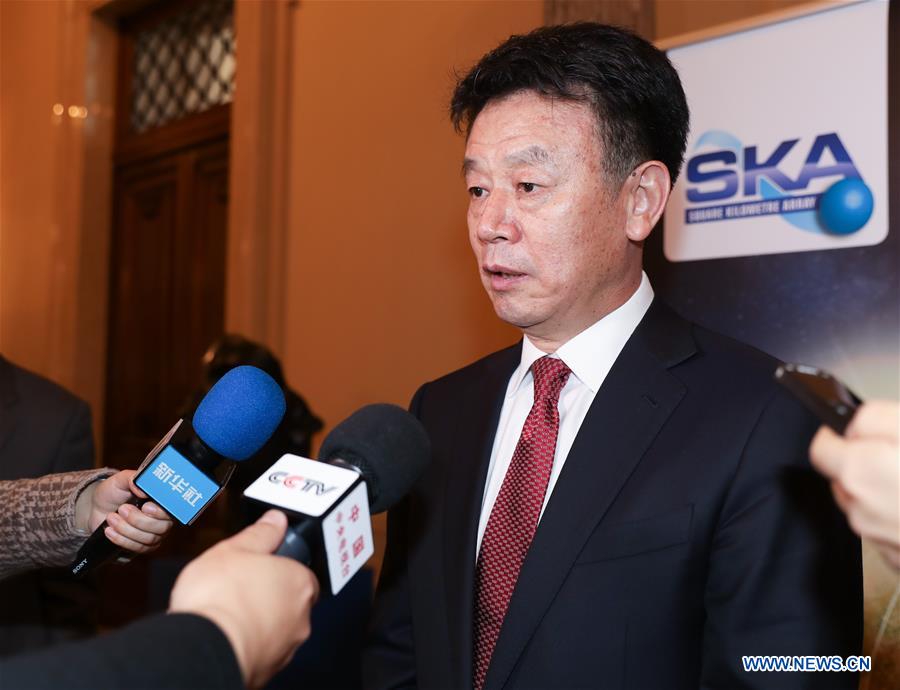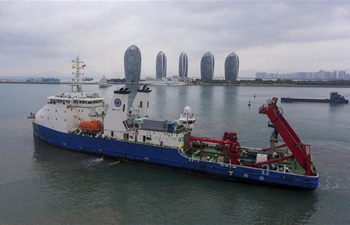
Chinese Vice Minister of Science and Technology Zhang Jianguo speaks to the media after signing the agreement to set up the body called Square Kilometre Array Observatory (SKA Observatory) in Rome, Italy, on March 12, 2019. An international treaty for the establishment of an intergovernmental organization overseeing the delivery of the world's largest radio telescope was signed here Tuesday. (Xinhua/Cheng Tingting)
by Alessandra Cardone
ROME, March 12 (Xinhua) -- An international treaty for the establishment of an intergovernmental organization overseeing the delivery of the world's largest radio telescope was signed here Tuesday.
Ministers and high-level representatives from seven countries -- Italy, China, Australia, UK, The Netherlands, Portugal, and South Africa -- signed the agreement to set up the body called Square Kilometre Array Observatory (SKA Observatory).
Sweden and India should follow, after going through a domestic process of approval, bringing the list of founding members to nine.
LARGEST SCIENCE FACILITY
"The SKA will be the largest science facility on the planet, with infrastructure spread across three continents on both hemispheres," the SKA Organization said in a statement.
Two networks of "hundreds of dishes and thousands of antennas" will be developed along hundreds of kilometres in Australia and South Africa, while the SKA headquarters would be in the UK.
"This will be one of humanity's cornerstone physics machines in the 21st century, together with facilities like the James Webb Space Telescope, CERN's Large Hadron Collider, the LIGO gravitational wave detector, the new generation of extremely large optical telescopes, and the ITER fusion reactor," the organization added.
Over the past five years, more than 1,000 engineers and scientists from 20 countries have been contributing to design the SKA Observatory, which was expected to "help address fundamental gaps in our understanding of the universe."
Foe examples, experts explained, it would allow astronomers "to study gravitational waves and test Einstein's theory of relativity in extreme environments, investigate the nature of the mysterious fast radio bursts, map hundreds of millions of galaxies, and improve our understanding of the evolution of the universe."
A REAL BEGINNING
Presiding over the ceremony, Italy's Minister of Education, University, and Research Marco Bussetti hailed the signature of the treaty, which came at the end of a path started with a Memorandum of Understanding (MoU) inked by eleven countries in UK in Aug. 2000.
"The SKA project is the icon of the increasingly strategic role that scientific research has taken on in contemporary society," the Italian minister said.
"Participating in the forefront of such an extensive international project is a great opportunity for the Italian scientific community, both for the contribution our many excellences can provide, and for sharing the big amount of data that SKA will collect and redistribute," he stressed.
Processing the "unprecedented amounts of data emanating from the telescopes" will indeed require two of the world's fastest computers, with some 600 petabytes to be stored and distributed to the scientific community worldwide every year, according to the organization.
A good return on investment for the countries and the companies involved in the project was also expected, with contracts worth about 700 million euros (789.9 million U.S. dollars) for the construction of the SKA due to be awarded from late 2020 on.
"For a project that has been going on for a long time, and that has now had several years of very serious developments arriving at the end of the design phase, this signature is the real beginning," SKA Board of Directors Chair Catherine Cesarsky remarked in a video message.
"This is a historic date that everybody will remember: SKA is a project that will be used for the next twenty, thirty, fifty years," the astronomer added.
CHINESE CONTRIBUTION
After signing the first MoU to establish the Int'l Steering Committee of the Square Kilometre Array in 2000, Italy was among the first countries involved in the project with its National Institute for Astrophysics (INAF).
China was also among the signatory countries of the 2000 Memorandum, and the Ministry of Science and Technology officially stepped in the SKA program in the pre-construction phase on behalf of the Chinese government in 2012.
Since 2013, a dozen Chinese universities, industry and research institutes have taken part in seven design consortia, according to the official presentation.
In a short declaration after taking part in the signature ceremony in the Italian capital, Vice Minister of Science and Technology Zhang Jianguo highlighted the importance China attached to the project.
"With seven countries officially signing the SKA Observatory Convention today, we believe more members will join SKA in the near future," Zhang said.
"We are certainly looking forward to working with all our partners... contributing Chinese strength for the world's largest radio telescope to explore the universe and Chinese wisdom to address the cosmic dawn, the cradle of life, and other common concerns of mankind."
Tuesday's signature would now give way to the legislative ratification process in the signatory countries. The SKA Observatory could enter into force by 2020 at the earliest, and, in any case, after five countries including all three hosts (Australia, South Africa, and UK) have ratified.










